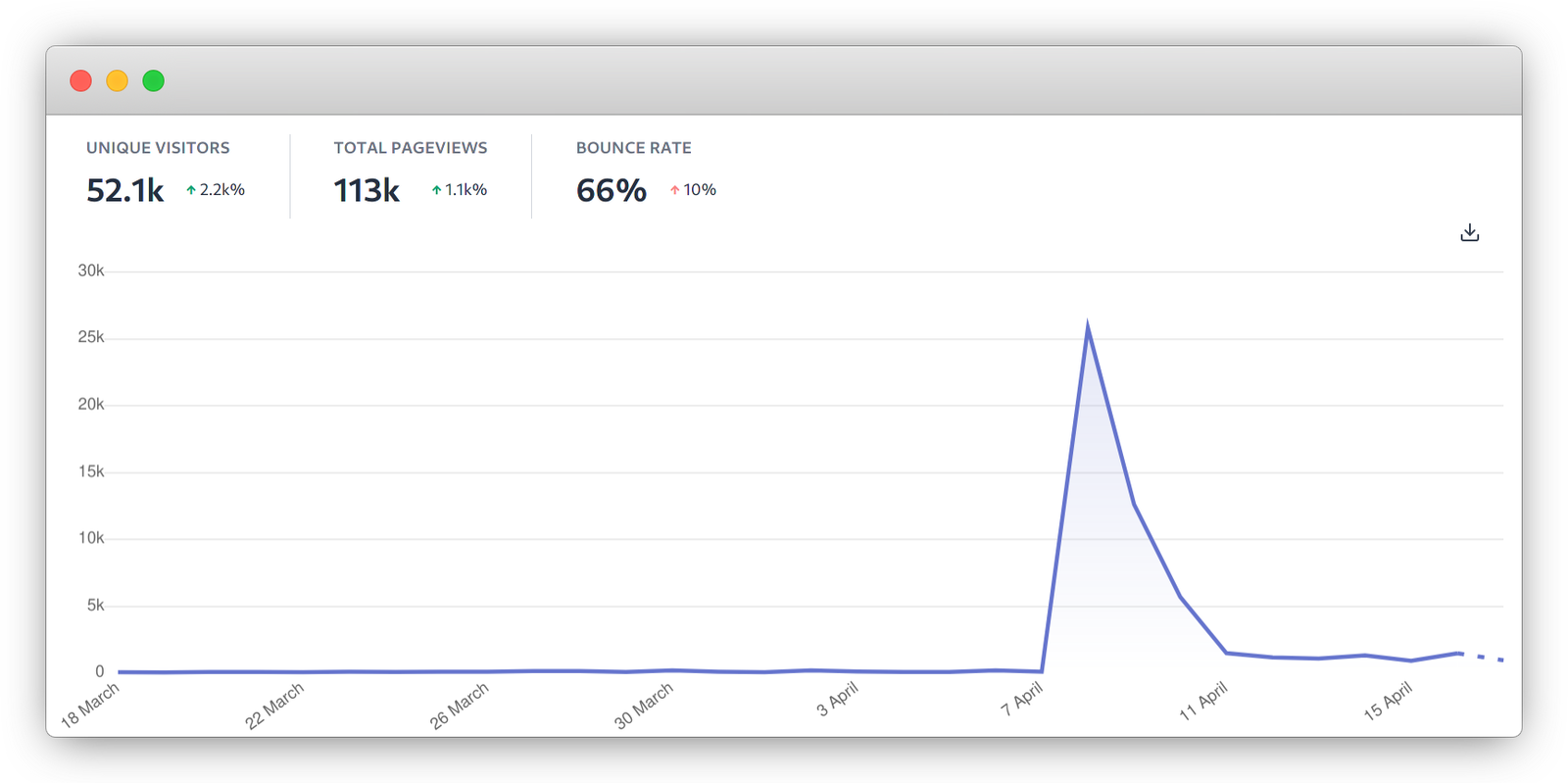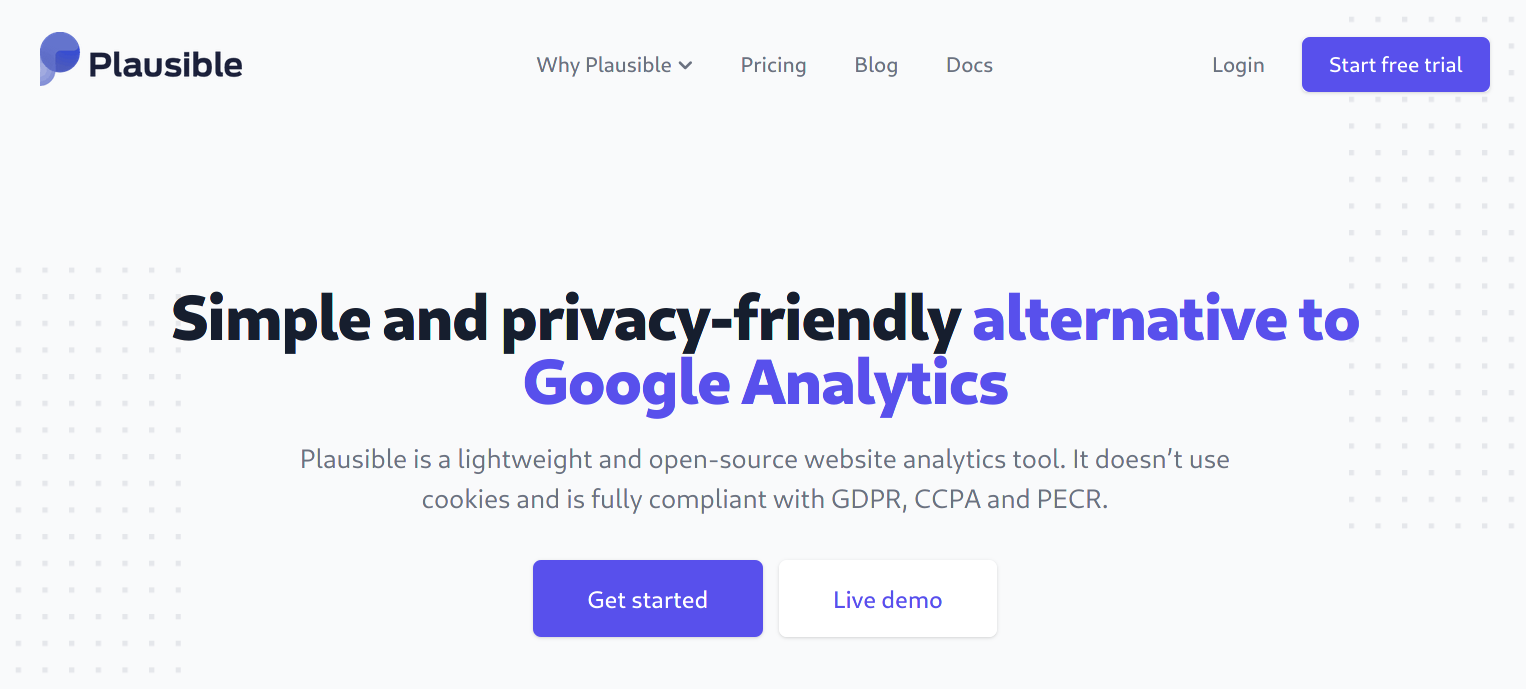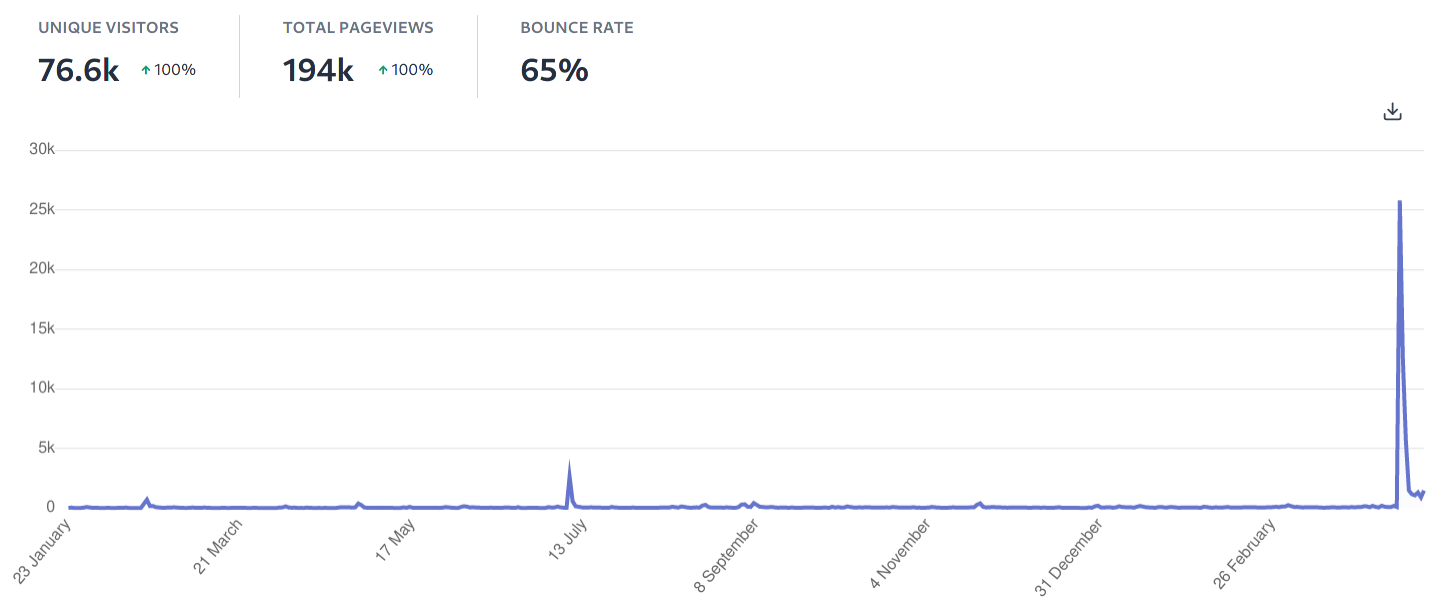How one blog post changed the traction for my startup

We recently relaunched Plausible Analytics as a no-cookie, GDPR compliant alternative to Google Analytics. We had some very eventful days and here’s what we learned.
We released a new product update, new website and the first blog post in a new series. This resulted in us breaking all of our website traffic and trial signup records. We were overwhelmed with feedback, comments, opportunities and new ideas too.
Here’s an overview of all the steps we’ve taken over the last couple of weeks and lessons we’ve learned that may help others in the indie startup community get their products out to more people too.
- Results of the first week after the “relaunch”
- Revamp of the product, website and blog
- How we do marketing for Plausible Analytics
- Early lessons learned from this new direction
- What we plan to do next
Results of the first week after the “relaunch”
The results were overwhelmingly positive:
- To the date of the new promotional push, we had 27,300 unique visitors in about 15 months. We got more than 48,000 unique visitors in the first week after the relaunch alone.
- We also got 166 new trials which is more than we got in four months prior to that combined.
- More than 1,400 developers explored our GitHub page where our code is. We more than doubled the number of stars on our GitHub repo too!
- Google featured our post in the Discover section of the Google app. This resulted in almost 200,000 impressions and 7,000 clicks.
- We got a boost of more than 300% in the number of impressions and clicks from Google’s organic search results.
- An interesting fact is that only 10 people searched for “Plausible Analytics” on Google in the week before the relaunch and 121 searched for our name the week after. More people are aware of our product.
- We were featured in some roundup articles, top lists of the day and even email newsletters that share some of the best content of the week.
- We also got hundreds of comments on different forums and social media. Some influential figures including Rand Fishkin and April Dunford shared our post. Other startups reached out to collaborate with us and there’s even an invite to be a guest on a popular podcast.
- One interesting feature of Plausible Analytics is the fact that you can open your dashboard and share your website stats with the public. We’ve done that so you can follow our stats on this live demo.
So this “relaunch” changed the traction of our startup, the goalposts have moved. Here’s a deeper look into the actions we took.
Revamp of the product, website and blog
Running a startup is about releasing new features and building a better product, but marketing and communication play a very prominent role too. A lot of work we did was to try and communicate better what our product does and why it’s worth considering.
Latest Plausible Analytics product update
As the first step, we released the latest update to the Plausible Analytics product. It was a popular feature request on our public roadmap. Plausible Analytics now works without cookies out of the box. You no longer need to have the cookie banner and you no longer need to obtain consent to store cookies if you use Plausible Analytics.
New Plausible Analytics website

No-cookie was a big feature for us so we decided to change and improve the home page at the same time. The thinking behind the new home page was to position us clearer as a Google Analytics alternative.
It is a fact that most websites use Google Analytics for their website tracking and that many of the people that sign up for Plausible usually do so coming from Google Analytics.
On our new home page, we wanted to explain what Plausible does and how it differs from Google Analytics. It’s a David vs Goliath-like situation as we’re a brand new startup while Google Analytics is installed on more than half of all the websites online.
The idea was to focus on things that we do differently and perhaps even better than Google Analytics. There’s no other way that a new startup can compete with a market leader.
New Plausible Analytics individual product pages
To better explain what Plausible Analytics does, we published several pages where we went into detail on the different features and the different ways that Plausible can help developers and site owners.
To come up with differentiators to focus on, we looked at what Google does wrong in our eyes, we collected all the feedback we had from our customers, from other people running websites and from researching things people talk about and search for. These differentiating features of Plausible fall into several categories:
- Simple to use: One of the main things people struggle with Google Analytics is the fact that it is too overwhelming. There are more than 100 different reports you get access to and almost 300 different metrics. Plausible Analytics presents everything you need to know at a glance so you can have more time to focus on your site.
- Lightweight script: Google Analytics with the Google Manager Tag adds lots of weight to your page size. Every KB matters if you want to speed up a site. Google Analytics script can hurt the site speed. Plausible Analytics script is lightweight which helps you keep your website fast and lean.
- Compliant with privacy regulations: Google Analytics places cookies and collects a lot of data from your visitors. You’re required to have a privacy policy, to show a cookie banner and to obtain consent for GDPR. Plausible Analytics doesn’t use cookies and doesn’t track personal data so you don’t need to annoy your visitors or worry about those prompts.
- Open source: Google Analytics is a closed source, proprietary product. It’s impossible to know what’s going on behind the scenes and you need to put your trust in Google. Plausible Analytics is transparent and open source with our code being publicly accessible on GitHub.
New Plausible Analytics comparisons with the most popular providers
To make matters even clearer for potential customers and help them make the best choice possible, we also published two different comparison posts putting Plausible Analytics head-to-head against the main website analytics providers.
- Google Analytics is the biggest site analytics platform on the web. 85% of sites that use web analytics use Google Analytics. Here’s the Plausible Analytics vs Google Analytics post.
- Matomo (formerly known as Piwik) is the most well-known open source alternative. It is used by 1.5% of all websites that use web analytics. We also published a Plausible Analytics vs Matomo comparison.
Both of these analytics products are powerful and well known by web developers and site owners. The intention with the comparison posts is to help us help them easier figure out what the differences are and why Plausible Analytics might be worth a look.
How we do marketing for Plausible Analytics
So with the new product update out, the new home page live and product pages online too, what steps did we take to drive traffic and raise awareness?
As a bootstrapped startup that is focused on providing a privacy-friendly alternative to Google Analytics, we have also decided not to focus on the traditional way of promoting a startup.
Many startups promote themselves using paid advertising on Google, Facebook and similar. This makes them part of the surveillance capitalism industry as targeted paid advertising requires a lot of personal data.
It’s also a very expensive and risky way of doing marketing that few without venture funding can afford in the long run. We may experiment with more ethical and privacy-friendly paid advertising in the future, but we’re focused on organic marketing for now as we believe that has the biggest potential.
So if you don’t use paid advertising, how do you attract an audience?
Content marketing has a big role to play here. We aim to publish content that helps people out. That may mean that we answer relevant questions that people have. Or that we solve relevant issues people are struggling with.
Content marketing doesn’t bring instant results like paid advertising does. You may put in time and effort to create a great blog post, and when you publish it, nobody might be there to see it. On the other hand, if you start a paid advertising campaign on Facebook now chances are that you will see a few clicks immediately.
Content marketing is a long term game. Unlike paid advertising which in most cases stops delivering results as soon as you stop paying for it, content marketing can deliver results weeks, months and even years after the original work has been done.
It takes a dedicated and concentrated strategic effort over a longer period of time to start seeing results but it keeps delivering results for longer too.
The first post we published in a new series on our blog was the obvious choice. It was based around a product that everyone in our target audience knows and has direct experience with: Google Analytics.
Some love, some hate it, some are indifferent. Some use it on all sites, some spend hours on it daily, most used it at least once in the past and everyone has an opinion on it. We published a post that looked into reasons why a site owner should stop using Google Analytics on their site.
It took a few days to research, write and edit and then we had almost 2,500 words of very relevant content that would be interesting to many people in our audience. We published the post and crossed our fingers.
This is where many people make a mistake and think that after publishing all the work is done. That’s false. The promotional work only starts after the blog post has been published.
Promotional activities after publishing a new post
After the content is published we need to try and see how we can reach a relevant audience of people interested in it.
Plausible Analytics is fairly new and we don’t have a large audience, so any content that we publish without taking any steps to actually share it with the world will most probably go unnoticed. No matter how great that content may be.
Especially in the early days of a startup, it’s really important to take steps to proactively go out there and share your message. Don’t spam people. Don’t go random places.
Find relevant communities and sites where people have shown interest in the topic you’re covering, join those communities and engage with them, and then share when you have something interesting.
We shared the post on our Twitter and Mastodon accounts, we shared it on Indie Hackers, Lobsters, Hacker News and Reddit too. At this stage with the post being in those communities, the things are really out of our hands.
Will the community pick it up? Will they ignore it? Will we get lucky so some people have a look before the post gets lost in hundreds of other posts, threads and submissions?
We got lucky with this post as people found it useful. And this is where the spike in traffic came from.

Early lessons learned from this new direction
- Find some areas where the market leader is lacking and design a replacement and an alternative with a focus on those. This will help you easier get your message across to people. You should not try to design a clone, a full-blown replacement and a feature-by-feature reproduction of the market leader. You don’t need to cover all the different use-cases of the most popular product. Cover a few that the market leader doesn’t care much about.
- Don’t hide the fact that a popular competitor and a market leader exists. People know. Rather than pretend they don’t exist, use their existence to your advantage. Clearly explain the differences between your product and the biggest player on the market. Publish comparison posts where you go into the detail on these differences. List reasons why your major competitor is flawed and explain what makes your solution a viable alternative.
- You don’t need a huge social media following. Plausible Analytics doesn’t (yet?) have official and active social media profiles but it doesn’t mean that we cannot get traffic from social media. Social media platforms focus on algorithmic newsfeeds. On Facebook for instance, the organic reach of posts from brands is demoted compared to posts from real people. This means that getting people to share your content has a higher chance of getting reach than you sharing it yourself through your brand page. By creating interesting and useful content, we tried to incentivize more people to share our message.
- Share the post that you’ve created. If you’ve put a lot of effort into creating a great post and you’re proud of it, make sure to share it with the world too. If you don’t put some effort into promoting the good work you’ve done, the chances it will go unnoticed and people won’t discover it at all. That would be a pity and waste of effort. Do not be afraid to go out there and tell your story.
- Monitor the conversation, listen, engage and act on insightful feedback. We got so much feedback on social, via email, different forums and on GitHub. Some added useful feedback such as this very insightful look into how we can make our script even lighter and this contribution for Docker. We’ve acted on a lot of the feedback already and fixed things such as the addition of pricing to the top navigation bar, updated and hand-crafted privacy policy, more clarification about pricing and various other fixes to the website. There’s also a list of feature ideas for us to work in our public roadmap.
-
Don’t be unhappy about the negative feedback. Be grateful that people care enough to comment and write to you in the first place. Learn from it. It’s better than being ignored. Some Hacker News feedback was that we were not upfront that we’re a Google Analytics competitor. Some people were happy with the way we approached things and defended us but this feedback is something we will consider for future posts.
By not putting ourselves up on top of the post, we were trying not to appear salesy or pushy. We even included several competing alternatives to Google Analytics and we listed our solution last in that list. The intention was to create the best possible post that looks into some of the issues with Google Analytics. We only put the mention of our product at the very end almost 2,500 words into the post. Perhaps we should put ourselves on the top of the next post and see what feedback we get then.
What we plan to do next
So what’s going to happen in the upcoming weeks and months? We plan to work on improving our product, our website, our communication and we plan to publish more useful content that we hope people may find interesting.
You can argue that the only way from here in terms of traffic is down. We hit the ball out of the park on our first blog post and this is an incredible result that is difficult to achieve very often.
It’s important to have realistic expectations when trying to promote a company using organic means. We will do our best and try to make progress each and every month. Growing a startup is a marathon, it’s not a sprint.
In the meanwhile, if you’re looking for an alternative to Google Analytics for your own website, do register for a 30 day Plausible Analytics trial.
It’s free, no credit card is required and it’s so lightweight you can easily run it alongside Google Analytics without any impact on your page speed. Test it and decide if Plausible Analytics is something worth removing Google Analytics for.